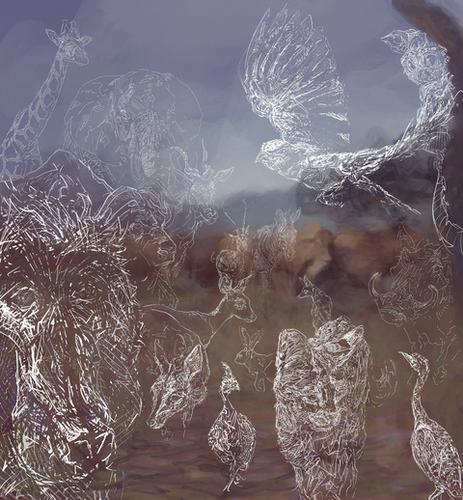当前位置:
X-MOL 学术
›
J. Appl. Ecol.
›
论文详情
Our official English website, www.x-mol.net, welcomes your
feedback! (Note: you will need to create a separate account there.)
Wild and domestic savanna herbivores increase smaller vertebrate diversity, but less than additively
Journal of Applied Ecology ( IF 5.0 ) Pub Date : 2021-02-01 , DOI: 10.1111/1365-2664.13843 Harry B.M. Wells 1, 2 , Duncan M. Kimuyu 3, 4 , Wilfred O. Odadi 3, 5 , Andrew J. Dougill 1 , Lindsay C. Stringer 1, 6 , Truman P. Young 3, 7
中文翻译:

野生的和家养的热带大草原草食动物增加了较小的脊椎动物多样性,但增加程度却不及
更新日期:2021-02-01
Journal of Applied Ecology ( IF 5.0 ) Pub Date : 2021-02-01 , DOI: 10.1111/1365-2664.13843 Harry B.M. Wells 1, 2 , Duncan M. Kimuyu 3, 4 , Wilfred O. Odadi 3, 5 , Andrew J. Dougill 1 , Lindsay C. Stringer 1, 6 , Truman P. Young 3, 7
Affiliation

|
- Cattle and other livestock graze more than a quarter of the world's terrestrial area and are widely regarded to be drivers of global biodiversity declines. Studies often compare the effects of livestock presence/absence but, to our knowledge, no studies have tested for interactive effects between large wild herbivores and livestock at varying stocking rates on small‐bodied wild vertebrates.
- We investigated the effects of cattle stocking rates (none/moderate/high) on the diversity of wildlife 0.05–1,000 kg using camera traps at a long‐term exclosure experiment within a semi‐arid savanna ecosystem in central Kenya. In addition, by selectively excluding wild ‘mesoherbivores’ (50–1,000 kg) and ‘megaherbivores’ (>1,000 kg; elephant and giraffe), we tested whether the presence of these two wild herbivore guilds (collectively, ‘larger wild herbivores’) mediates the effect of cattle stocking rate on habitat use and diversity of ‘smaller wildlife’ (mammals ranging between 10 and 70 cm shoulder height and birds).
- Our results show that cattle enhance alpha diversity of smaller wildlife (with or without larger wild herbivore presence) and of all wildlife 0.05–1,000 kg (with or without megaherbivore presence), by altering vegetation structure. However, for smaller wildlife, this effect is less pronounced in the presence of larger wild herbivores, which also shorten grass. In the absence of cattle, mesoherbivore‐accessible sites showed higher alpha diversity of smaller wildlife than sites excluding mesoherbivores.
- Smaller wildlife habitat use was increased by high cattle stocking rates and wild mesoherbivores more in the presence of the other.
- Synthesis and applications. Our findings imply that grazing, whether by livestock or wildlife, can enhance local savanna wildlife diversity. The biodiversity benefits of localised increases in herbivory are likely to be due to shortened grass and associated visibility improvements (for predator avoidance/foraging). This suggests that land managers can increase local biodiversity by shortening grass, with wild or domestic herbivores (or both), at least in patches within a taller grass matrix.
中文翻译:

野生的和家养的热带大草原草食动物增加了较小的脊椎动物多样性,但增加程度却不及
- 牛和其他牲畜在世界陆地面积的四分之一以上吃草,被广泛认为是全球生物多样性下降的驱动力。研究通常会比较牲畜存在与否的影响,但据我们所知,尚无任何试验检验大型野生食草动物与牲畜在不同放养率下对小型野生脊椎动物的相互作用。
- 在肯尼亚中部半干旱热带稀树草原生态系统的长期暴露实验中,我们使用相机诱捕器研究了牲畜饲养率(无/中/高)对0.05–1,000 kg野生动物多样性的影响。此外,通过有选择地排除野生的“中食食动物”(50–1,000公斤)和“巨型食肉动物”(> 1,000公斤;大象和长颈鹿),我们测试了这两种野生食草动物行会(统称为“较大的食草动物”)是否存在介导牲畜放养率对栖息地利用和“较小野生动物”(哺乳动物的肩高和鸟类之间介于10到70厘米之间)多样性的影响。
- 我们的结果表明,通过改变植被结构,牛可以提高较小的野生动物(有或没有较大的草食动物存在)和所有野生动物0.05-1,000 kg(有或没有巨食草动物)的阿尔法多样性。但是,对于较小的野生动植物,在存在较大的野生食草动物的情况下,这种影响并不明显,这也缩短了草丛。在没有牛的情况下,与中草食肉动物相比,可接近中草食动物的地点显示出较小的野生生物具有更高的阿尔法多样性。
- 较高的牲畜放养率增加了野生动植物栖息地的使用,而在其他情况下野生中生草食动物的使用增加了。
- 综合与应用。我们的发现表明,无论是牲畜还是野生动植物,放牧都可以增强当地稀树草原野生动植物的多样性。食草的局部性增加对生物多样性的好处可能是由于草缩短了和相关的能见度得到了改善(避免捕食/觅食)。这表明土地管理者可以通过缩短野生或家畜食草动物(或两者兼有)的草,至少在较高草丛中的片块中,来增加当地的生物多样性。











































 京公网安备 11010802027423号
京公网安备 11010802027423号